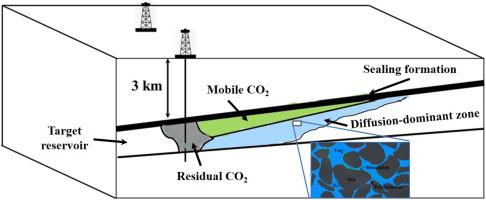International Journal of Greenhouse Gas Control ( IF 4.6 ) Pub Date : 2021-03-06 , DOI: 10.1016/j.ijggc.2021.103283 Heng Wang , Vladimir Alvarado , Davin A. Bagdonas , J. Fred McLaughlin , John P. Kaszuba , Dario Grana , Erin Campbell , Kam Ng

|
Geologic carbon sequestration (GCS) is considered a feasible technology for storing substantive volumes of greenhouse gases in subsurface geological formations. In the reservoir, far from carbon dioxide (CO2) injection wells or in post-injection scenarios, diffusion dominates over advection. This condition conjoins with spatially distributed geochemical reactions to induce heterogeneous changes in pore architecture, i.e. pore body and throat sizes or surface roughness. These changes can affect CO2 transport properties and storage capacity. In this work, we investigated mineral dissolution and precipitation in dolomite samples saturated with a CO2-saturated brine at 93 C and 34.5 MPa, aged without flow. Two rock types samples, i.e. intergranular- and vuggy-dominant, were selected to investigate changes in pore size, porosity and permeability under reactive conditions. Mineral dissolution and precipitation were characterized using scanning electron microscopy. Changes in pore size were quantified via time-domain nuclear magnetic resonance (TD-NMR) transverse relaxation time () and diffusion coefficient () distributions. We show that mineral dissolution likely occurs in highly permeable pathways. These observations are confirmed through analysis of () and diffusion coefficient () distributions. In contrast to results during CO2-enriched brine continuous injection, mineral precipitation was observed in micropores. The leftward shift of the peaks, corresponding to micropores, also evidenced mineral precipitation in low-permeability zones. However, microscale alterations resulted only in a subtle increase in porosity and permeability. Results in this study shed light on effects of geochemical reactions on alteration of rock properties in diffusion-dominated regions during CO2 storage.
中文翻译:

CO 2卤水-岩石反应对白云岩孔隙结构和渗透性的影响:对CO 2储存和EOR的意义
地质碳固存(GCS)被认为是用于在地下地质构造中存储大量温室气体的可行技术。在远离二氧化碳(CO 2)注入井的储层中或在注入后的情况下,扩散对流占主导地位。这种情况与空间分布的地球化学反应结合在一起,从而引起孔隙结构的异质变化,即孔隙体和喉道的大小或表面粗糙度。这些变化会影响CO 2的传输特性和存储容量。在这项工作中,我们研究了在93°C下用CO 2饱和盐水 饱和的白云岩样品中矿物的溶解和沉淀。C,34.5 MPa,时效,无流动。选择了两种岩石类型的样品,即沿晶和疏松为主,以研究反应条件下孔隙尺寸,孔隙度和渗透率的变化。使用扫描电子显微镜表征矿物的溶解和沉淀。孔径的变化通过时域核磁共振(TD-NMR)横向弛豫时间()和扩散系数()分布。我们表明,矿物溶解可能发生在高渗透性途径中。这些观察结果通过对()和扩散系数()分布。与连续注入富含CO 2的盐水过程中的结果相反,在微孔中观察到矿物沉淀。的左移与微孔相对应的峰值也证明了低渗透区的矿物沉淀。但是,微观尺度的变化仅导致孔隙度和渗透率的微妙增加。这项研究的结果揭示了在CO 2储存过程中,地球化学反应对扩散占主导的区域岩石性质变化的影响。









































 京公网安备 11010802027423号
京公网安备 11010802027423号